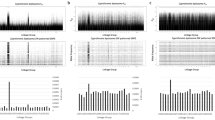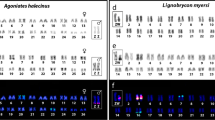Abstract
Although the sex-determining gene DMY has been identified on the Y chromosome in the medaka, Oryzias latipes, this gene is absent in most Oryzias species. Recent comparative studies have demonstrated that, in the javanicus species group, Oryzias dancena and Oryzias minutillus have an XX/XY sex determination system, while Oryzias hubbsi has a ZZ/ZW system. Furthermore, sex chromosomes were not homologous in these species. Here, we investigated the sex determination mechanism in Oryzias javanicus, another species in the javanicus group. Linkage analysis of isolated sex-linked DNA markers showed that this species has a ZZ/ZW sex determination system. The sex-linkage map showed a conserved synteny to the linkage group 16 of O. latipes, suggesting that the sex chromosomes in O. javanicus are not homologous to those in any other Oryzias species. Fluorescence in-situ hybridization analysis confirmed that the ZW sex chromosomes of O. javanicus and O. hubbsi are not homologous, and showed that O. javanicus has the morphologically heteromorphic sex chromosomes, in which the W chromosome has 4,6-diamino-2-phenylindole-positive heterochromatin at the centromere. These findings suggest the repeated evolution of new sex chromosomes from autosomes in Oryzias, probably through the emergence of new sex-determining genes.
Similar content being viewed by others
References
Charlesworth D, Charlesworth B, Marais G (2005) Steps in the evolution of heteromorphic sex chromosomes. Heredity 95: 118–128.
Ganguly A, Rock MJ, Prockop DJ (1993) Conformation-sensitive gel electrophoresis for rapid detection of single-base differences in double-stranded PCR products and DNA fragments: evidence for solvent-induced bends in DNA heteroduplexes. Proc Natl Acad Sci U S A 90: 10325–10329.
Graves JAM (2002) The rise and fall of SRY. Trends Genet 18: 259–264.
Graves JAM (2006) Sex chromosome specialization and degeneration in mammals. Cell 124: 901–914.
Hamaguchi S, Toyazaki Y, Shinomiya A, Sakaizumi M (2004) The XX-XY sex-determination system in Oryzias luzonensis and O. mekongensis revealed by the sex ratio of the progeny of sex-reversed fish. Zool Sci 21: 1015–1018.
Hauser MT, Adhami F, Dorner M, Fuchs E, Glossl J (1998) Generation of co-dominant PCR-based markers by duplex analysis on high resolution gels. Plant J 16: 117–125.
Kasahara M, Naruse K, Sasaki S et al. (2007) The medaka draft genome and insights into vertebrate genome evolution. Nature 447: 714–719.
Kimura T, Yoshida K, Shimada A et al. (2005) Genetic linkage map of medaka with polymerase chain reaction length polymorphisms. Gene 363: 24–31.
Kondo M, Nagao E, Mitani H, Shima A (2001) Differences in recombination frequencies during female and male meioses of the sex chromosomes of the medaka, Oryzias latipes. Genet Res 78: 23–30.
Kondo M, Nanda I, Hornung U, Schmid M, Schartl M (2004) Evolutionary origin of the medaka Y chromosome. Curr Biol 14: 1664–1669.
Kondo M, Hornung U, Nanda I et al. (2006) Genomic organization of the sex-determining and adjacent regions of the sex chromosomes of medaka. Genome Res 16: 815–826.
Matsuda M, Matsuda C, Hamaguchi S, Sakaizumi M (1998) Identification of the sex chromosomes of the medaka, Oryzias latipes, by fluorescence in situ hybridization. Cytogenet Cell Genet 82: 257–262.
Matsuda M, Sotoyama S, Hamaguchi S, Sakaizumi M (1999) Male-specific restriction of recombination frequency in the sex chromosomes of the medaka, Oryzias latipes. Genet Res 73: 225–231.
Matsuda M, Kawato N, Asakawa S et al. (2001) Construction of a BAC library derived from the inbred Hd-rR strain of the teleost fish, Oryzias latipes. Genes Genet Syst 76: 61–63.
Matsuda M, Nagahama Y, Shinomiya A et al. (2002) DMY is a Y-specific DM-domain gene required for male development in the medaka fish. Nature 417: 559–563.
Matsuda M, Sato T, Toyazaki Y, Nagahama Y, Hamaguchi S, Sakaizumi M (2003) Oryzias curvinotus has DMY, a gene that is required for male development in the medaka, O. latipes. Zool Sci 20: 159–161.
Matsuda M, Shinomiya A, Kinoshita M et al. (2007) The DMY gene induces male development in genetically female (XX) medaka fish. Proc Natl Acad Sci U S A 104: 3865–3870.
Matsuda Y, Chapman VM (1995) Application of fluorescence in situ hybridization in genome analysis of the mouse. Electrophoresis 16: 261–272.
Nagai T, Takehana Y, Hamaguchi S, Sakaizumi M (2008) Identification of the sex-determining locus in the Thai medaka, Oryzias minutillus. Cytogenet Genome Res 121: 137–142.
Nanda I, Shan Z, Schartl M et al. (1999) 300 million years of conserved synteny between chicken Z and human chromosome 9. Nat Genet 21: 258–259.
Nanda I, Kondo M, Hornung U et al. (2002) A duplicated copy of DMRT1 in the sex-determining region of the Y chromosome of the medaka, Oryzias latipes. Proc Natl Acad Sci U S A 99: 11778–11783.
Naruse K, Tanaka M, Mita K, Shima A, Postlethwait J, Mitani H (2004) A medaka gene map: the trace of ancestral vertebrate proto-chromosomes revealed by comparative gene mapping. Genome Res 14: 820–828.
Phillips RB, DeKoning J, Morasch MR, Park LK, Devlin RH (2007) Identification of the sex chromosome pair in chum salmon (Oncorhynchus keta) and pink salmon (Oncorhynchus gorbuscha). Cytogenet Genome Res 116: 298–304.
Raymond CS, Shamu CE, Shen MM et al. (1998) Evidence for evolutionary conservation of sex-determining genes. Nature 391: 691–695.
Rice WR (1996) Evolution of the Y sex chromosome in animals. Bioscience 46: 331–343.
Skaletsky H, Kuroda-Kawaguchi T, Minx PJ et al. (2003) The male-specific region of the human Y chromosome is a mosaic of discrete sequence classes. Nature 423: 825–837.
Takehana Y, Naruse K, Sakaizumi M (2005) Molecular phylogeny of the medaka fishes genus Oryzias (Beloniformes: Adrianichthyidae) based on nuclear and mitochondrial DNA sequences. Mol Phylogenet Evol 36: 417–428.
Takehana Y, Demiyah D, Naruse K, Hamaguchi S, Sakaizumi M (2007a) Evolution of different Y chromosomes in two medaka species, Oryzias dancena and O. latipes. Genetics 175: 1335–1340.
Takehana Y, Naruse K, Hamaguchi S, Sakaizumi M (2007b) Evolution of ZZ/ZW and XX/XY sex-determination systems in the closely related medaka species, Oryzias hubbsi and O. dancena. Chromosoma 116: 463–470.
Tanaka K, Takehana Y, Naruse K, Hamaguchi S, Sakaizumi M (2007) Evidence for different origins of sex chromosomes in closely related medaka fishes: Substitution of the master sex-determining gene. Genetics 177: 2075–2081.
Uwa H (1986) Karyotype evolution and geographical distribution in the ricefish, genus Oryzias (Oryziidae). In: Uyeno T, Arai R, Taniuchi T, Matsuura K eds. Indo-Pacific Fish Biology: Proceedings of the second international conference on Indo-Pacific fishes. Ichthyological Society of Japan, Tokyo, pp. 867–876.
Uwa H, Iwata A (1981) Karyotype and cellular DNA content of Oryzias javanicus (Oryziatidae, Pisces). Chromosome Inf Serv 31: 24–26.
Yamamoto T (1961) Progenies of sex-reversal females mated with sex-reversal males in the medaka, Oryzias latipes. J Exp Zool 146: 163–179.
Zarkower D (2001) Establishing sexual dimorphism: conservation amidst diversity? Nat Rev Genet 2: 175–185.
Author information
Authors and Affiliations
Corresponding author
Rights and permissions
About this article
Cite this article
Takehana, Y., Hamaguchi, S. & Sakaizumi, M. Different origins of ZZ/ZW sex chromosomes in closely related medaka fishes, Oryzias javanicus and O. hubbsi . Chromosome Res 16, 801–811 (2008). https://doi.org/10.1007/s10577-008-1227-5
Received:
Revised:
Accepted:
Published:
Issue Date:
DOI: https://doi.org/10.1007/s10577-008-1227-5




